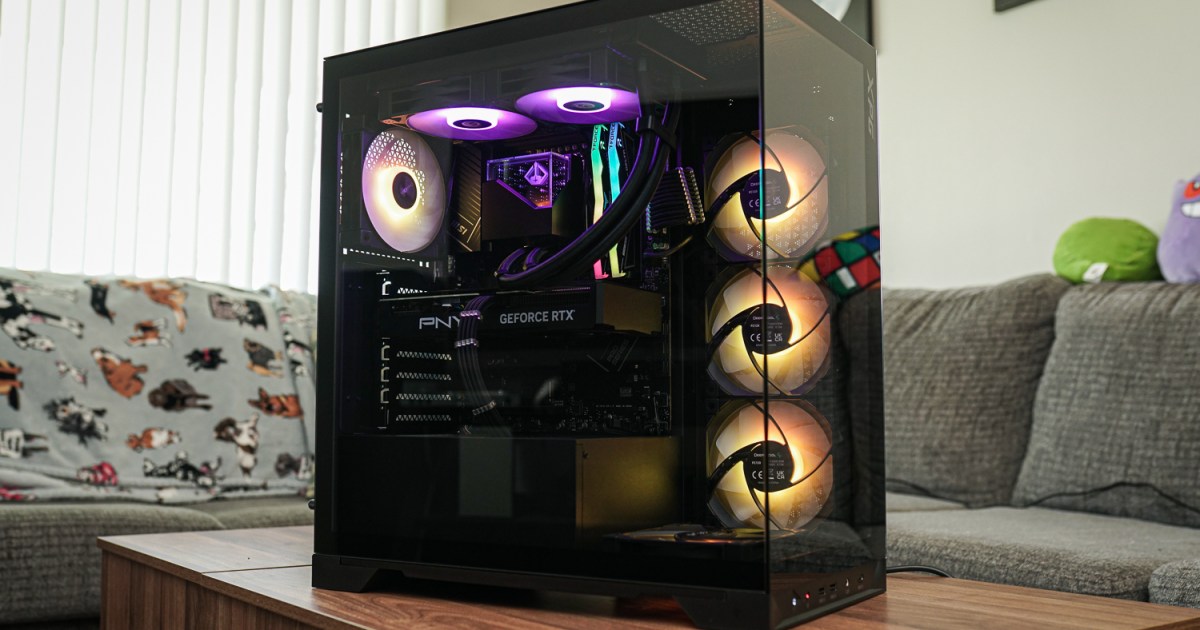Starforge Systems Navigator
MSRP $1,900.00
“The Starforge Systems Navigator makes a compelling argument for prebuilt gaming PCs.”
Pros
- Excellent build quality
- No bloatware
- Solid performance
- Two-year warranty
Cons
- A bit expensive
- No extra power supply cables
Names like Asmongold, Emiru, MoistCr1TiKaL, and Sodapoppin should be familiar to you if you linger on Twitch day after day. Outside of being some of the most successful streamers on the platform, they all share something else in common — a resounding endorsement of gaming PCs built by Starforge Systems.

Get your weekly teardown of the tech behind PC gaming
Starforge Systems is an interesting anomaly in the world of prebuilt gaming PCs. It’s not just a matter of successful Twitch streamers putting their seal of approval on a piece of hardware. According to Starforge, these creators actually own the company, or at least a portion of it.
I received the Navigator, which is in the middle of the pile of the 15 different configurations that Starforge Systems currently offers. It hits a sweet spot in terms of price and performance, and even among a sea of rival PC builders, the Starforge Navigator feels like a PC worthy of the names that back it.
Specs and pricing
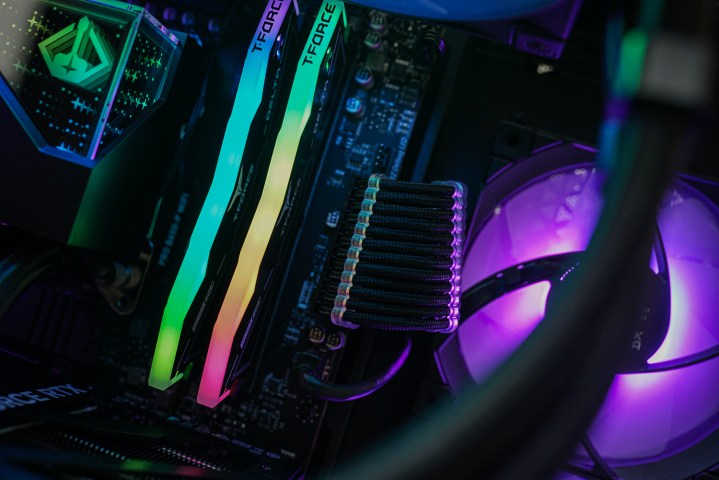
But let’s meet the Navigator. It’s a $1,900 PC that features pretty solid specs for the price. You’re getting an RTX 4070 GPU, 1TB of PCIe 4.0 storage, 32GB of DDR5-6000 memory, a 240mm liquid cooler from DeepCool, and a solid branded motherboard and power supply from MSI.
One thing I appreciate about Starforge is that it lists the specific components you’re getting in the build — a lot of builders swap parts out depending on availability, meaning you might get something you weren’t expecting in the mail.
The only exception is the graphics card. The Navigator comes with an RTX 4070, and Starforge has an MSI model pictured on its product page. I received a PNY model. GPUs are volatile, and it’s unreasonable to assume Starforge would maintain inventory of a specific model of graphics card, so it gets a pass here.
| CPU | AMD Ryzen 5 7600X |
| CPU Cooler | Starforge Custom DeepCool LT520 240mm Liquid Cooler |
| Memory | Teamgroup Delta RGB 32GB DDR5-6000 (2x16GB) |
| GPU | Nvidia RTX 4070 |
| Motherboard | MSI Pro B650-P Wi-Fi |
| Storage | 1TB PCIe 4.0 NVMe SSD |
| Power supply | MSI MAG A750GL PCIe 5.0 |
| Case | XPG Invader X |
If you take all of the components here and price them out, it comes out to about $1,450, plus a few additional fans and a Windows key. Starforge is charging $1,900, which is a very reasonable price. It’s about $400 for the build fee, and for that, you get a two-year parts and labor warranty. The real boon for Starforge, however, is that you can see what you’re actually getting before you buy it. There isn’t a list of generic specs, and I wasn’t surprised to see the final product when it showed up on my doorstep.
I’m reviewing the Navigator, but there are a lot of other options. The Horizon II is the cheapest build at $1,050, and it comes with an AMD RX 6650 XT and Intel Core i5-12400F. At the top end, you can drop $4,600 on the Voyager II Elite, which comes kitted out with an Intel Core i9-14900K and Nvidia RTX 4090.
Inside the Starforge Navigator
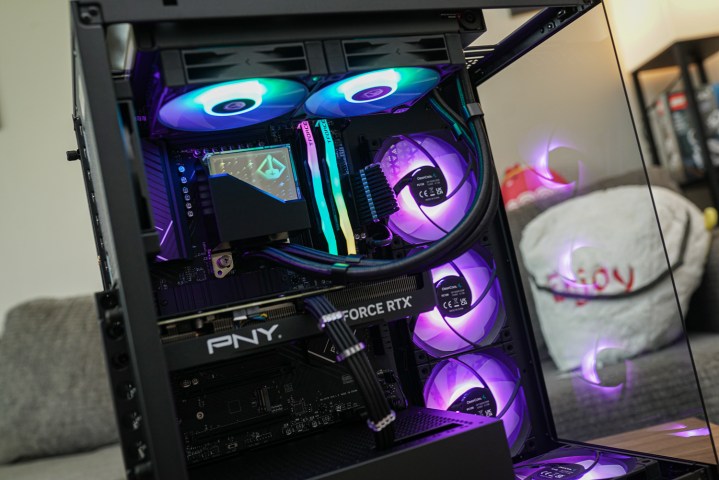
Unboxing the Navigator was a breeze. Unlike the CLX Hathor or Origin Neuron, you don’t have to contend with a costly wooden shipping crate to get to your PC. It’s a cardboard box, fit with some bubble wrap to keep the PC safe. Starforge uses expandable foam inside the PC to support the graphics card and other internal components, and everything showed up at my door in perfect condition.
Starforge is a bit heavy on the fans, likely for aesthetic reasons, but it makes the PC louder than it needs to be. The fans ramp up when the PC is under load, as expected, but there’s a constant hum coming from the rig due to the seven fans in the relatively small case.
Still, the fans are configured in a smart way here. There are four intakes, three on the side and one on the bottom, and three exhausts, one at the rear and two on top through the liquid cooler. The XPG case Starforge uses includes dust filters for all of the intakes, so keeping the PC clean shouldn’t be a hassle.
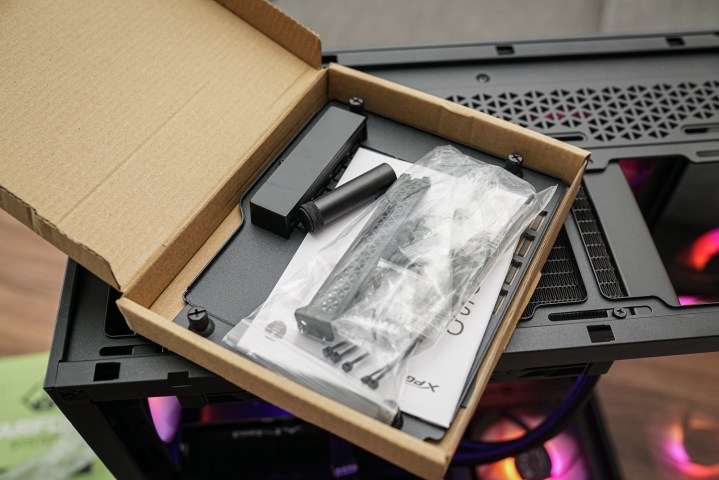
In addition to the PC, you get an accessories case, a power cable, and a quick start guide. The start guide is helpful, though it should note the plastic that covers the liquid cooler. There’s a thin layer of plastic over the liquid cooler, and it’d be easy to miss in the rush of setting up a new gaming PC.
The accessories box held a suite of goodies that were included with the XPG case, including a vertical GPU mount, extra screws, cable ties, and even a GPU support. Starforge oddly doesn’t include any extra power supply cables, however. Someone familiar with PCs could separate what’s what here, but a bit of documentation for newcomers would be helpful with a suite of disparate parts like this.
The inside of the PC is a dream. Starforge has excellent cable management, and it includes some comforts like cable combs to keep the front bay looking tidy. This is much better attention to detail than you get with something like the MSI Aegis RS 12, and a good argument for a system integrator over a mainstream brand.
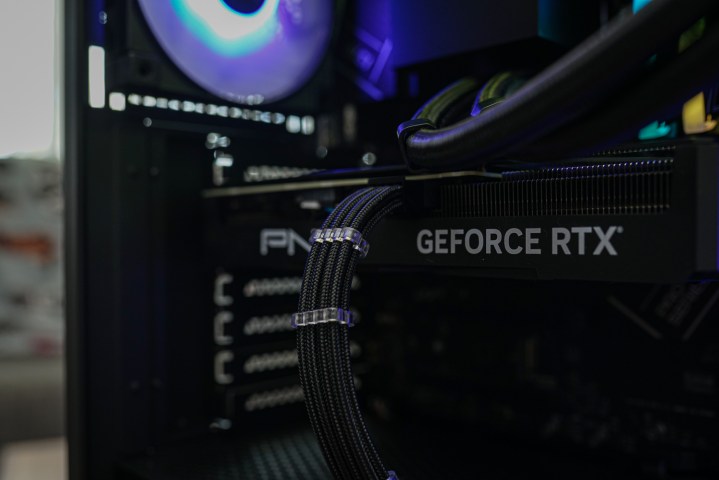
I can only speak for the PC I reviewed. I’ve seen a handful of other reviews that have spotted issues like the SSD heat sink sticker still being applied and connectors not being seated fully. These problems have been showcased by massive names like Gamers Nexus and Linus Tech Tips, and further amplified by the streamers serving as a face for Starforge Systems.
In short, I believe Starforge is aware of the attention paid to its PCs given its star-studded slate of owners, and I don’t believe oversights like this will be common or widespread.
Warranty and support
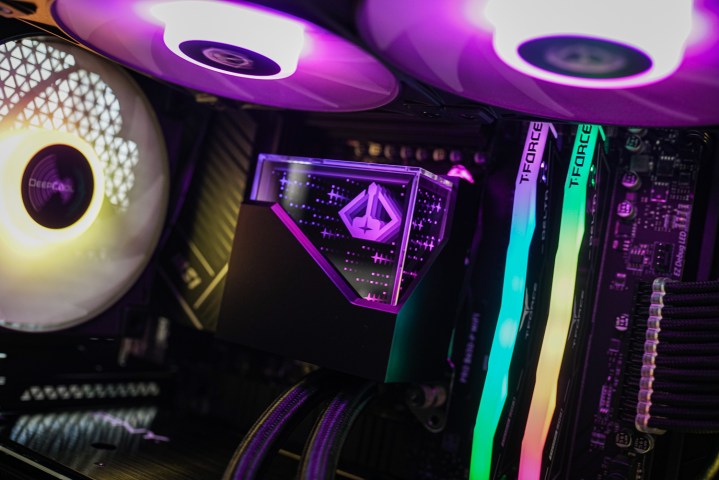
Starforge includes a two-year warranty on all new PCs, covering hardware and labor for the “core computer.” The company defines that as the original hardware in the PC, short of any special requests or monitors ordered alongside the PC. If you have a valid claim, Starforge says it will replace or repair your PC under the warranty.
One exception to this warranty is modification. If you change anything in the PC or otherwise tinker inside, there’s a good chance your warranty claim will be denied. Thankfully, Starforge doesn’t place any warranty stickers at critical entry points, so as long as you’re not breaking anything when opening the PC, you should be safe under the warranty — I won’t tell if you won’t.
In addition to the warranty, you get 30 days to return the system for a refund. Shipping isn’t included in the refund, unless the return was due to the system being damaged during transit. Beyond that point, Starforge still accepts returns, but you’ll be charged a 15% restocking fee, as well as a “rental fee” of $75 per day beyond the return window.
Bloatware and configuration
Starforge makes a strong argument for going with a smaller system integrator rather than a mainstream brand like HP, Asus, or Lenovo. A big reason why is software. The Navigator doesn’t come bogged down with a barrage of software, with Starforge instead opting for a few useful apps, which means you can dive in and start using your PC right away.
There’s no bloatware here. Starforge preinstalled Google Chrome and the Nvidia App on my review unit, both of which are apps I immediately reach for with a new PC. The BIOS looked good as well, with both Resizable BAR enabled and the overclocking profile for the memory selected.
Performance
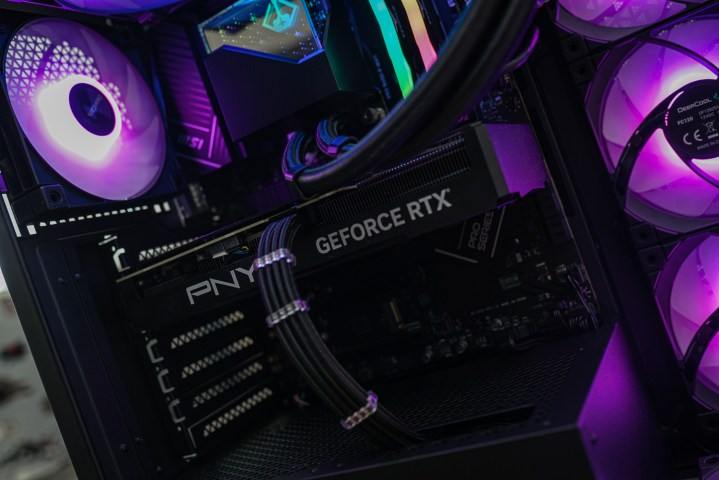
The Starforge Navigator uses off-the-shelf components. The goal with it is to match the performance you can get with these parts if you built the PC yourself, and the Navigator meets that standard. I ran it through a series of benchmarks, testing against the results I saw when testing the Ryzen 5 7600X and RTX 4070 individually.
| Starforge Navigator | Ryzen 5 7600X reference PC | |
| Cinebench R23 multi-core | 14,751 | 15,366 |
| Cinebnehc R23 single core | 1,948 | 1,965 |
The Ryzen 5 7600X is a six-core CPU, which is a bit underpowered for productivity use. It’s a good place to cut when building a focused gaming rig, however. In Cinebench, the Ryzen 5 7600X was a bit behind the multi-core score I achieved with the stock part, though it managed to match the speed in the single-core benchmark.
It’s not too big of a trade-off, and likely down to variance between the CPUs themselves. The more interesting benchmarks are for the GPU. Starforge says this a rig for “1080p Ultra” gaming, though that’s selling it short. The RTX 4070, as you can read in our RTX 4070 review, is squarely a 1440p graphics card with aspirations for 4K.
| Starforge Navigator | RTX 4070 reference PC | |
| Horizon Zero Dawn 4K | 78 fps | 78 fps |
| Cyberpunk 2077 4K | 27 fps | 31 fps |
| Cyberpunk 2077 4K ray tracing | 17 fps | 18 fps |
| Cyberpunk 2077 4K ray tracing w/ DLSS 3 | 61 fps | 73 fps |
| Returnal 4K | 50 fps | 52 fps |
| Returnal 4K ray tracing | 39 fps | 41 fps |
| Returnal 4K ray tracing w/ DLSS 3 | 88 fps | N/A |
| Red Dead Redemption 2 | 63 fps | 65 fps |
Starting with the 4K benchmarks, the Starforge Navigator is right in line with what I expect to see from the RTX 4070. There are some places where the reference PC is ahead, most notably in Cyberpunk 2077 with DLSS 3 enabled, but you’re consistently getting over 60 frames per second (fps) in demanding games at this resolution, either natively or through some combination of upscaling and frame generation.
| Starforge Navigator | RTX 4070 reference PC | |
| Horizon Zero Dawn 1440p | 142 fps | 146 fps |
| Cyberpunk 2077 1440p | 74 fps | 72 fps |
| Cyberpunk 2077 1440p ray tracing | 37 fps | 39 fps |
| Cyberpunk 2077 1440p ray tracing w/ DLSS 3 | 120 fps | 121 fps |
| Returnal 1440p | 89 fps | 90 fps |
| Returnal 1440p ray tracing | 75 fps | 76 fps |
| Returnal 1440p ray tracing w/ DLSS 3 | 154 fps | N/A |
| Red Dead Redemption 2 | 99 fps | 99 fps |
Things are more comfortable at 1440p, with games like Horizon Zero Dawn shooting well above 100 fps. Once again, Starforge is within a frame of my reference PC in most games, showcasing that there aren’t too many bottlenecks here for the GPU.
The main drawback here for gaming is the CPU. The Ryzen 5 7600X is a solid gaming CPU, but a faster CPU could make a big difference for games that can scale up on the processor, such as Cyberpunk 2077. In this build, the Ryzen 7 7800X3D seems like an obvious choice for a high-end rig, so a few options to swap out the CPU would help tailor the PC for the other components inside.
Should you buy the Starforge Systems Navigator?
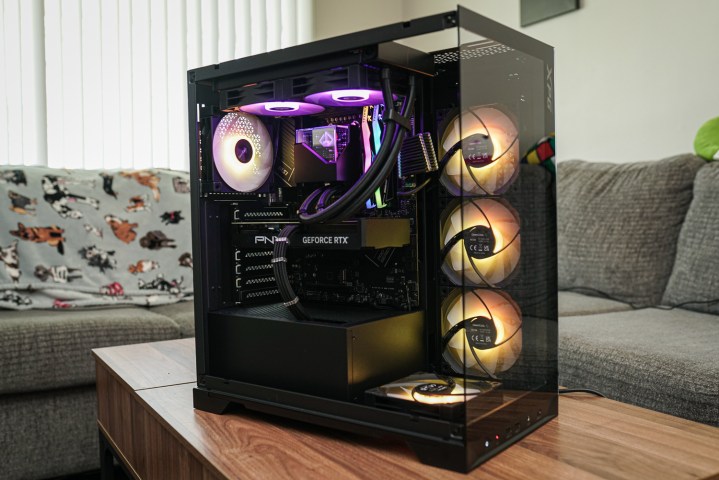
There are a lot of system integrators on the market. Some of them build solid PCs, and others are so problematic you could call them a scam. Thankfully, Starforge Systems fits into the former category. There’s still a modest build fee here of around $400, but that’s fair considering the attention to detail inside the PC.
Cable management is excellent, and performance lined up with my expectations. The PC is a bit loud due to being stuffed with fans, and you don’t have a ton of options for a GPU upgrade without extra power supply cables, but for a PC that’s built well and runs well, you could do a lot worse.
Editors’ Recommendations

Wanda Parisien is a computing expert who navigates the vast landscape of hardware and software. With a focus on computer technology, software development, and industry trends, Wanda delivers informative content, tutorials, and analyses to keep readers updated on the latest in the world of computing.

